Digital Payments Are Transforming the Face of Grocery

As connected technologies increasingly make their way into the grocery industry, digital payments both in stores and online are changing the way consumers engage with merchants.
Overall, in-store shopping remains far and away how most consumers are purchasing their groceries, but its share of total grocery purchases is slipping, according to findings from PYMNTS’ Digital Economy Payments study.
The latest edition, “Digital Economy Payments: The Rise Of Mobile eCommerce,” which draws from a survey of more than 2,700 U.S. consumers about their shopping habits, finds that 84% reported buying groceries in store. This share is down from 85% the two quarters before and 87% in December 2021. The decline is modest but noticeable, and eCommerce giants continue to pick off brick-and-mortar grocers’ customers, product category by product category.
Get the study: Digital Economy Payments: The Rise Of Mobile eCommerce
“Subscription services such as Amazon Subscribe & Save and [direct-to-consumer (D2C)] specialty brands are whittling away the center aisle purchases from grocery stores — of course, at different paces with different merchants in different countries — and will for some time,” PYMNTS’ Karen Webster observed in a September feature.
Indeed, a significant portion of consumers purchase groceries online. According to data from the July edition of PYMNTS’ ConnectedEconomy™ series, “The ConnectedEconomy™ Monthly Report: The Rise of the Smart Home,” which drew from a survey of more than 2,600 U.S. consumers, 40% order groceries online for home delivery every month. Plus, the majority of those eGrocery customers do so once a week or more.
Read the report: The ConnectedEconomy™ Monthly Report: The Rise of the Smart Home
When it comes to online grocery, mobile is the go-to, the Digital Economy Payments study reveals. It noted that 10% of consumers purchase groceries online using a mobile device. In contrast, only 5% do so online using a computer.
In fact, mobile grocery purchasing continues to increase, while computer purchasing is on the decline. In December 2021, just 7% of consumers reported making mobile grocery purchases, and at that time 6% were shopping for groceries with their computers.
These online grocery shoppers expect quick and convenient payment options. PYMNTS’ study “How We Pay Digitally: Stored Credentials Edition,” created in collaboration with Amazon Web Services (AWS), which features the results of a survey of 2,100 U.S. consumers, finds that 63% of eGrocery customers reported having used stored payment information to make these purchases in the 30 days prior to the survey.
Download your copy: How We Pay Digitally: Stored Credentials Edition
Across digital and physical channels, meanwhile, digital wallet payments are becoming increasingly popular. Data from PYMNTS’ October study “Connected Wellness: The Next Prescription for Healthcare Providers — Digital Wallets,” which draws from a September survey a census-balanced panel of more than 2,600 U.S. consumers, reveals that 24% of those asked had used digital wallets to pay for their most recent grocery purchase.
View the study: Connected Wellness: The Next Prescription for Healthcare Providers — Digital Wallets
Digital wallets are not the only connected technology changing how consumers pay for their groceries in stores. Next-gen self-checkout features are also transforming the process. In September, grocery technology giant Instacart announced its Connected Stores bundle. The move includes a redesigned Caper Cart smart cart that helps customers navigate the store and then check out without manually scanning items as well as a Scan & Pay function that lets customers scan items as they shop and then pay for them on their mobile phones.
“We believe the future of grocery won’t be about choosing between shopping online and in-store – consumers are going to do both,” Instacart CEO Fidji Simo in the news release. “The launch of Connected Stores is another exciting step for Instacart as we partner with retailers to help invent the future of grocery.”
